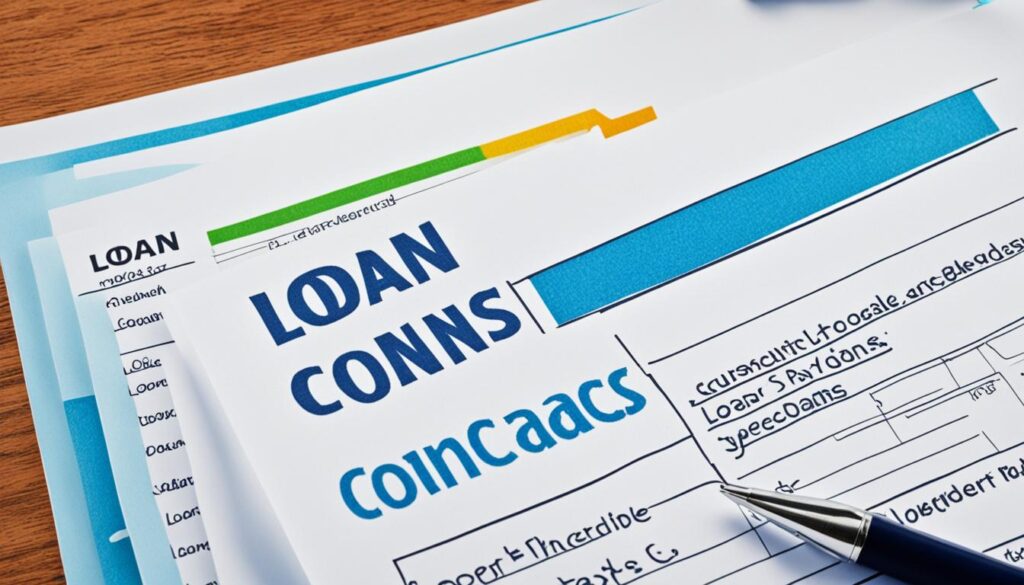A loan agreement is a written deal between a borrower and a lender. It covers the loan amount and the repayment schedule. It also spells out what to do if there’s an issue with paying back the loan. This contract makes sure everyone knows what to expect.
Key Takeaways
- A loan agreement is a written contract that formalizes the terms of a loan between a borrower and a lender.
- The agreement outlines the loan amount, repayment schedule, interest rate, and what happens if the borrower defaults.
- Loan agreements protect both the borrower and the lender by specifying the rights and responsibilities of each party.
- Personal loan agreements are often used when borrowing from family or friends, in addition to traditional lenders.
- Understanding the key components of a loan agreement is important before signing and accepting a loan.
Purpose of a Loan Contract
A loan agreement or loan contract is key in documenting a personal loan. It’s between a borrower and a lender. The goal is to clearly set the rights and duties for both sides.
Defining Agreed Terms
The loan agreement sets down the exact loan terms. This includes the loan amount, interest rate, when to pay back, and any fees or penalties. It makes sure everyone knows what they have to do.
Compliance with Regulations
Unlike when you get a mortgage or a car loan, personal loans are unsecured. The loan agreement makes sure your loan follows the law. It looks out for the borrower and the lender. This contract lays out the rules for the entire loan period.
Specifying Loan Usage
Some loans have rules about how you can spend the money. This is common in business or home improvement loans. The agreement will list what you can use the loan for. It makes sure the agreement is followed correctly.
Key Components of a Loan Contract
A well-crafted loan agreement covers important details. It protects the lender and the borrower. This includes the loan amount, interest rate, fees, collateral, and more. All of this is clearly described and must be followed legally.
Loan Amount and Repayment Schedule
The loan agreement outlines the loan amount and repayment schedule. It shows when payments are due and how they work. It’s important that both the full loan amount and how it will be repaid are clear.
It also states how the security for the loan amount works. This is the pay the loan amount through the payments on the loan.
Interest Rate and Fees
The interest rate, along with any fees, is clearly laid out. This includes the annual percentage rate (APR) and extra fees like late fees. It helps the borrower know all the costs upfront.
Collateral and Security
If there’s collateral for the loan, the agreement describes it. This might be real estate or vehicles. It shows the security for the loan amount and how it covers the loan in case of issues.
Default Terms and Penalties
The loan contract explains what happens if the borrower can’t repay. It lists penalties like late fees. And, it can talk about the lender’s rights to the collateral if needed.
| Key Component | Description |
|---|---|
| Loan Amount | The total loan amount being provided, including the full loan amount and security for the loan amount. |
| Repayment Schedule | Details on when the loan payments are due, the loan terms, and how the borrower will repay the loan or pay the loan over time. |
| Interest Rate and Fees | The interest rate, annual percentage rate (APR), and any associated fees or penalties. |
| Collateral and Security | Assets used to secure the loan amount and how they will be used to pay the loan in the event of default. |
| Default Terms and Penalties | Consequences and penalties for failing to repay the loan or pay the loan according to the loan terms. |
Types of Loan Contracts

Loan agreements come in many forms. There are personal loans, mortgages, auto loans, and business loans. Each agreement has its unique rules.
Personal Loans
Many people use personal loans. They are for big expenses like debt merging, house fixing, or sudden costs. Personal loans are not backed by things like a house or car. So, it’s easier for someone to borrow money this way.
Mortgages
A mortgage helps buy a home. The house itself is the loan’s security. The buyer pays back in installments over time. Mortgages are more detailed and have specific rules to obey.
Auto Loans
Auto loans are for buying cars. The car itself secures the loan. Payments are usually monthly. Auto loans often have shorter terms than mortgages. They might also come with different interest rates.
Also Read : Pathway To Financial Freedom: Capital One Personal Loan
Business Loans
Business loans assist in starting or growing a company. They might need some item as a guarantee, or not. Entrepreneurs use these loans to take care of business expenses.
It’s always wise to look closely at any loan’s terms. Make sure you know what you’re agreeing to before signing up. Whether it’s a personal loan or another type, be wise with your borrowing.
Loan Contract

Loan agreements are legal documents. They formalize a loan process between two or more people. These are different from promissory notes. They lay out the loan’s terms and conditions. They make sure both the borrower and the lender are fair and clear. This helps avoid disagreements and keeps things honest through the loan’s life.
A loan contract lists key details like how much is borrowed, the interest, and when it’s paid back. Fees and penalties are also spelled out. This document means the loan agreement is clear for everyone. It prevents fights or confusion between the borrower and lender.
No matter if it’s for a home, personal need, or for a business, a good contract is a must. It makes sure everyone’s rights and duties are protected. With a solid agreement in place, the loan can be made while following the rules.
Creating a Personal Loan Agreement

When writing a personal loan agreement, it’s crucial to protect the borrower and the lender. Here are the key parts to include:
Identifying Information
The personal loan agreement needs the parties’ full names, addresses, and contact info – the lender and the borrower. This makes sure everyone is clearly identified and records are kept well.
Loan Details and Terms
The loan agreement must have the loan amount, the interest rate, and any fees or charges. It should explain what the loan is for, like for personal, education, or business reasons.
Repayment Schedule
The repayment schedule is very important in a personal loan agreement. This part explains how the borrower will pay back the loan. It includes the payment amounts, due dates, and the total number of payments. Both the borrower and the lender should agree on this repayment plan.
Penalties and Remedies
The personal loan agreement should also talk about penalties for late payments and what the lender can do if the borrower doesn’t pay back the loan. This might involve charges, fees, or taking legal action to get back the loan amount. that protects the interests of both the borrower and the lender, and ensures a smooth and legally bindingloan transaction
How Does a Loan Contract Work?
Additional Clauses in Loan Contracts
Loan agreements, besides covering the loan amount and interest rates, include extra clauses. These clauses add more protection and make things clearer for the borrower and lender alike.
Successors
The agreement says that its terms apply to anyone who takes over the loan. This keeps the contract’s rules in place, even if new people own or manage it. The loan’s key points stay intact no matter what.
Legal Expenses
If a legal fight happens over the contract, the losing side usually pays the legal bills. This way, the loan’s recipient isn’t unfairly burdened with legal costs.
Modification
If changes are needed, the agreement spells out how they can happen. Both parties have to follow specific steps to change the contract. This keeps everything fair and agreed-upon.
Credit Verification
Some agreements let lenders check a borrower’s credit now and then. This helps the lender keep track of the borrower’s money situation. It aims to nip any financial problems in the bud, protecting both sides.
FAQs
Q: What is a loan contract?
A: A loan contract, also known as a loan agreement, is a written agreement between a lender and a borrower that outlines the terms and conditions of a loan, including the amount borrowed, interest rate, repayment terms, and any other relevant details.
Q: How is a loan agreement different from a promissory note?
A: While both a loan agreement and a promissory note are legal documents related to borrowing money, a promissory note is a more simple document that contains the borrower’s promise to repay the loan, whereas a loan agreement is a more comprehensive contract that outlines the terms of the loan.
Q: What should be included in a loan agreement?
A: A loan agreement should include details such as the loan amount, interest rate, repayment schedule, late payment penalties, any collateral or security provided, and any other terms and conditions agreed upon by the lender and borrower.
Q: Why is it important to write a loan agreement?
A: Writing a loan agreement is important because it helps to clearly define the terms of the loan and protect the interests of both the lender and the borrower. It serves as a legal document that can be used as evidence in case of any disputes or misunderstandings.
Q: Where can I find a free loan agreement template?
A: You can find free loan agreement templates online on various legal websites or template repositories. These templates can be customized to suit your specific loan agreement needs.
Q: What are the terms of a loan that I should be aware of?
A: Some key terms of a loan agreement that you should be aware of include the repayment term, interest rate, any fees or penalties, whether the loan is secured or unsecured, and any rights and responsibilities of both parties involved.
Q: Can I pay off a loan early?
A: Whether you can pay off a loan early or not depends on the terms stated in the loan agreement. Some loan agreements may have prepayment penalties, while others allow for early repayment without penalties. It’s important to review the agreement carefully.





